
Alger Hiss
He swore to tell the truth.
Alger Hiss
The Ever Changing Definitive Conclusions
The story of Alger Hiss just won't go away. The arguments pro and con as to whether the former high level State Department official was a Russian spy continue unabated.
Briefly put, there are two options. One is:
The evidence is so complete and overwhelming that Alger Hiss was a spy for the Soviet Union that only the most numbskulled and delusional leftist apologists could hold a scintilla of a possibility that he was innocent.
And the other is:
The so-called evidence that Alger Hiss was guilty is as weak and flabby as it ever was, and only the most iron-headed and rabid right-wing automaton can accept what is clearly perjured testimony and fabricated evidence against a man who served his country as few of his accusers have ever done.
But first the basics.
Whittaker Chambers was born in Philadelphia in 1901. After graduating from high school he studied at Columbia University. There like many idealistic but foolish young men he became fascinated by the writings of Karl Marx. Whit (as his friends called him) was so enamored with Marxist ideas and philosophy that he joined the American Communist Party (CPUSA) and openly wrote for Communist publications.
That's all well and good. After all, being a member of the Communist Party was not (and is not) a crime.
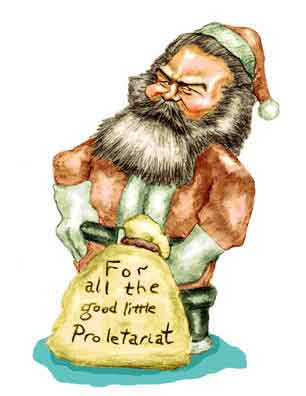
Karl Marx
Whit was impressed.
But spying for the relatively new Soviet Union was. And Whit soon began to act as a Russian agent.
You'll read in some places that Whit served as a primary conduit for high level information. Some commentators even say that Whit was - quote - "the major link" - unquote - with the spies and Moscow.
Such a characterization might be a pardonable exaggeration of Whit's importance. But there's no doubt that he was a salaried Russian operative. He took and obeyed orders from an officer of the General Staff of the Soviet Military (GRU), Colonel Boris Bykov. And yet all the while he considered himself a loyal American.
Today people wonder. Why would loyal Americans help the Communists? After all, the Commies were trying to tear down the very fabric of the country.
But remember. When Whit got involved with the CPUSA, the Communists were among the few groups that were calling for workers' rights and for the abolishment of segregation. And the Soviet Constitution specifically forbade any discrimination based on race, religion, and ideology. Yet in America "separate but equal" remained the law of the land.
In the 1920's Russia also became a world leader in art, with creative composers like the prodigious Dimitri Shostakovich and the modernist Sergei Prokofiev. Even in that newest art - cinema - directors like Sergei Eisenstein were producing films that today are considered models of innovation. As Will Rogers said after he visited Russia in the 1920's, this all sounded so good, but ...
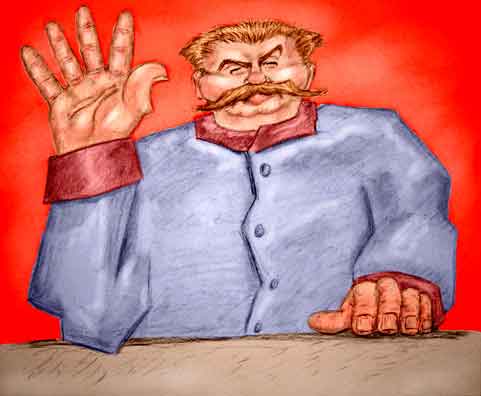
Iósif Vissariónovich Dzhugashvili
He changed his name.
Whit's spying continued well into the late 1930's. But because of the Great Purges of Iósif Vissariónovich Dzhugashvili (who mercifully changed his name to Stalin for the benefit of English speakers) Whit had second thoughts. He became particularly nervous when Colonel Boris kept trying to get him to confess that he, Whit, was not a loyal follower of Josef but instead was a secret supporter of Josef's greatest rival Leon Trotsky.
But the beet that spoiled the borscht was when one of Whit's friends, a lady named Juliet Poyntz, left her apartment in New York and was never seen again. When Whit asked what was going on, Boris simply smiled that she had "gone with the wind."
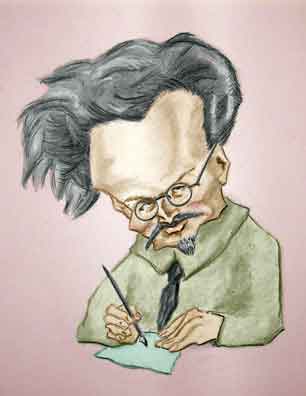
Leon Trotsky
Joe's biggest rival.
Then if there was any doubt about the character of the Soviet leader, that came to an end in 1939. Long seen by his American admirers as an implacable foe of Fascism, Josef signed the (in)famous German-Soviet Nonaggression Pact with Hitler. Josef and Adolf were now best friends forever.
Disillusioned with Communism and fearing for his life, Whit went underground. He also took some documents he said he had received from spies within the US government and had them transferred to microfilm. These documents were not originals but were handwritten or typed copies. The originals could then be returned to the government files with no one the wiser. Collectively these documents became known as the "Pumpkin Papers" because years later Whit briefly hid the microfilm in a pumpkin.
With the zeal of the converted, Whit became a rabid anti-Communist. Now realizing that his fears of personal retaliation were largely unwarranted, he joined the staff of Time Magazine, then run by the quite conservative publisher Henry Luce. Whit quickly became one of its more well-respected writers and editors. Such a position naturally brought him into contact with many of the Washington bigwigs.
Thoroughly convinced that Josef in particular and Communism in general were threats to the world, Whit immediately went to Adolf Berle, a member of President Franklin Delano Roosevelt's much vaunted Brain Trust.
Whit more or less spilled his guts. Whit confessed his duplicity and then said that he knew a lot of spies in the United States government. Among the names mentioned was a member of the staff of the Assistant Secretary of State Francis Sayre. This was (who else?) Alger Hiss.
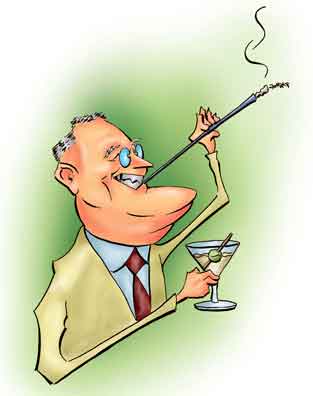
Franklin Roosevelt
He pooh-poohed the rumors.
Alger had an impressive background. A graduate of both Johns Hopkins University and Harvard, Alger had clerked for the famous Supreme Court Justice Oliver Wendell Holmes. Then once Franklin Roosevelt became President, Alger joined the New Deal Administration and rose in the ranks at the State Department.
In 1945 and as the Second World War came to its end, Alger had been in the American entourage at the famous Yalta Conference where the Big Three, Franklin, Josef, and British Prime Minister Winston Churchill, met to figure out what to do at the end of the War. The same year Alger served as Secretary General Pro Tem at the inaugural meeting of the United Nations in San Francisco. He remained in the State Department until 1946 when he left the government service.

Winston Churchill
One third of the Big Three.
Adolf Berle took notes of his meeting with Whit and summarized them to FDR. But Franklin pooh-poohed them as a bunch of hooey. There's no way these high level diplomats could be in cahoots with the Russians. So things languished for a couple of years.
Then in 1941 came yet another volte-face. Hitler scrapped his peace pact with Stalin and sent his armies barreling into the Soviet Union. Suddenly the Russians were our allies, and Uncle Joe was the grandfatherly leader of the Russian people. One article in Life Magazine - also published by Henry Luce - extolled the virtues of the Soviet system with its smiling happy workers on the prosperous productive collective farms. It's hilarious.
Naturally after the war ended in 1945, Josef's standing changed yet again. The Soviet Union was now occupying much of Eastern Europe and had split Germany (and the former capital, Berlin) down the middle. So once more the Commies were the bad guys.
In 1948, the House Un-American Activities Committee or HUAC (pronounced hew-ACK) began heeding the rumors of widespread espionage. They began formal investigations on the extent to which Soviet agents had penetrated into the United States government. One of the willing witnesses was Whit.
After swearing to tell the truth, Whit named the men he had worked with as a young, misguided, and impressionable Communist spy. It was essentially the list he had given to Adolf Berle six years before. Many shrugged off the accusations and decided not to dignify the accusations with a comment.
Except one.
And that was ...
... Alger Hiss.
Alger immediately went into spittle-flinging diatribes saying he had never met a man named Whittaker Chambers. He asked to appear before the committee to clear his name.
In his testimony Alger assured the committee he was not now nor ever had been a member of the Communist Party. His testimony was impressive and many of the committee members believed, as did President Truman, that the whole investigation was a waste of time.

Dick Nixon
Happy with the arrangement.
(Click on image to zoom in.)
However, one member of the committee was the junior congressman from California, Richard Milhous Nixon. He thought they couldn't let things hang like that. Alger and Whit had both testified under oath but only one was telling the truth. Dick got permission to form a subcommittee to see who it was.
When asked about Alger, Whit said he met often with Alger and his pretty elfin wife, Priscilla, in their home. He described a close friendly relationship where they celebrated anniversaries and drank champagne together. Whit was also able to give detailed information about Alger's personal life that wouldn't be known to only passing acquaintances. For instance, he said Alger was an avid bird watcher. Once when Whit was staying at Alger's home, Alger had returned from an outing and waxed eloquently that he had seen a prothonotary warbler.
Dick called an executive session. Executive sessions are particularly convenient if you have sensitive information since no one present is allowed to talk about what went on. Out of the public eye, instead of the polite and respectful queries that Alger had encountered before the full committee, Alger now found himself peppered with tough and skeptical questions.
Still maintaining he had never met anyone named Whittaker Chambers, Alger was then shown a picture of Whit. Hm. Well, maybe the man did look familiar. He might have been a man who Alger had known as George Crosley. George, Alger remembered, had very bad teeth.
Then Dick asked Alger if he had any hobbies. Yes, said Alger, one of them was ornithology. Then Congressman John McDowell of Pennsylvania asked if Alger had ever seen a prothonotary warbler? Not realizing he was being set up, Alger replied, why, yes, he had and right here in Washington. In the eyes of a number on the committee members, this answer tipped the balance in favor of Whit's credibility.
Finally Alger and Whit were brought face to face. Alger asked Whit if he was George Crosley. Whit answered not that he knew of. He then asked Alger if he was Alger Hiss.
This exchange was decidedly odd regarding both men. Whit was a hard guy to forget. But it was only after checking Whit's teeth, that Alger said yes, this was the man he had known as George Crosley.
Then there's the problem with the way Whit responded to seeing Alger. In his testimony Whit had described a relationship with Alger and Priscilla that can only be called close and familiar. And yet Whit asked Alger if he was Alger Hiss. This doesn't fit with people who spent time at each other's homes quaffing champagne and talking about birds.
So even though there were legitimate questions regarding Whit's story of his intimacy with Alger and Priscilla, the tone of the hearings had sifted from the presumption of Alger's innocence to deep suspicion. If Alger wanted to refute the accusations of someone whom Dick and others on the committee found increasingly creditable, well, that was fine with them.
That the shift in tone occurred during the executive hearings has had some historians wondering if Dick's personal feelings influenced how he pursued the case. To his mind Alger had come off as an arrogant, pompous prig.
The hearings then went public. For the first time, television cameras broadcast live testimony given before a congressional committee. Now the congressmen found Alger's answers to be "vague and evasive" and Whit's testimony "forthright". Things did not look good for Alger. Nevertheless, Alger continued to maintain his innocence.
Since the proceedings were an inquiry and not a court proceeding, Alger had few options to clear his name. Only he could address the committee and although he had legal representation, the lawyer could give advice but not actually speak on behalf of the client.
But then Whit appeared on Meet the Press and repeated his story. Since his immunity did not extend outside of Congress, Alger immediately filed a slander suit.
PROOF say Alger's friends that he must have been innocent. Only a person reckless to the point of insanity would take action that would give the accuser the opportunity to prove his case. Alger's actions could only be those of an innocent man.
Huh! say Alger's detractors. Alger just thought it was going to be Whit's word against his. And who would you believe? A fat slob with rotten teeth and rumors of, well, of certain "tendencies". Or a tall, slim, and distinguished public servant with friends in high places?
Given that either Whit or Alger had lied under oath, a grand jury was called in. Alger testified that he never gave Whit any documents and that he had not seen Whit after January 1, 1937.
Then arose something that Alger didn't consider. The Pumpkin Papers were now in the hands of the investigators. Whit said that the documents were either copies from Alger's own hand or made by Priscilla on Alger's personal typewriter.
The irony is that these documents would likely have remained hidden if not for Alger's slander suit. But for their case, Whit's lawyer had asked him to provide any other documents that might be relevant. So Whit handed the Papers over.
The documents were dated 1938. So if authentic, they were evidence that Alger had met with Whit after Alger said he last met with "George Crosley".
The documents were given to the FBI for forensic evaluation. The official pronouncement was 1) the typed documents were prepared on the same typewriter from Alger's home and 2) the handwritten documents were written by Alger.
Alger never questioned the forensic findings. He admitted the documents were in his handwriting. As far as the typed documents coming from his typewriter, he wondered just how the heck Whit could have gotten into his house and used his typewriter.
Alger's detractors roll their eyeballs in disbelief. Here we go again! Claims of faked evidence is always the last gasp of the guilty trying to refute ironclad proof.
But wait a minute, Alger said. He no longer had the typewriter. He had given it away a long before the date on the Pumpkin Papers. Unfortunately, no one could pin down the actual date Alger gave the machine away.
Eventually the FBI located a machine that they said was the one. And the typefaces matched those that typed the Pumpkin Papers.
Some of Alger's champions have suggested that the typewriter the FBI found wasn't even Alger's. There certainly was no verifiable "chain of custody" which is now considered important when introducing evidence. Besides, some claim that the serial number indicates the typewriter was manufactured after the Pumpkin Papers were copied.
Alger's detractors hoot in derision. Even the manufacturers say you could not ID the year of manufacture, not even by the serial number. Nice try, Alger.
Nevertheless the idea that someone could fiddle with the typefaces was not impossible. Forensic comparison of typewriters often depends on small differences of only a few keys. Although not easy, it is possible to artificially "age" the faces to match the keys on another machine, and modern spy agencies - such as the CIA and it's predecessor the Office of Strategic Services (the OSS) - are capable of such "forgery by typewriter". However few people thought that Whit had either the know-how or the wherewithal to pull that kind of stuff off.
But then arose the strange case of Horace Schmahl. Horace had been one of Alger's defense team. But without warning he had he switched to working for the prosecutors. We should note that during the war Horace had been a member of the OSS.
So if not Whit, say Alger's friends, Horace had the wherewithal to finagle the necessary forgeries. So not only was Alger innocent, he was being railroaded.
Nonsense, snort Alger's detractors. Horace had just realized Alger was guilty and joined the side of righteousness.
Ironically, Alger didn't have to worry about being convicted of spying - which could carry the death penalty. At that time many laws had surprisingly limited statues of limitations. For espionage it was only five years. Alger's alleged spying had been more than ten years before.
But there was that pesky problem of Alger's recent testimony before the grand jury. The jury looked at the evidence and issued an indictment against Alger for perjury. The charges specified he had lied under oath when he said he never met with Whit after January 1, 1937, and that he hadn't given Whit any documents.
Alger's trial began in 1949. The testimony was scarcely helpful to Alger. Priscilla took the stand and was asked if she had been a member of the Socialist Party. She said no. But she had no real response when the prosecutor pulled out a voter registration that listed Priscilla as a Socialist.
Priscilla's other testimony wasn't any better. She admitted she had typed the pages that had been used by the FBI used to verify the Pumpkin Papers. As to when they had given the typewriter away, she said it could have been as late as 1943.
Still the trial ended in a hung jury, eight to four for conviction. At that point the options were either to dismiss the charges or go for a new trial. The prosecutors went for the trial.
Alger's second trial was almost a textbook study for showing defense lawyers how to lose a case. For one thing the defense decided not to waste much time refuting the evidence. Instead they called in a psychiatrist to show that Whit was a nutball.
If ever the words "junk science" could be applied, it fits the psychiatric testimony in the Alger Hiss case. Whit, said the psychiatrist, had a psychopathic personality and was a pathological liar. And the evidence? Well, that was because Whit was untidy, looked up at the ceiling during his testimony, and equivocated in some of his answers.
In the cross examination, the prosecutor asked, oh, so you know Whit had a psychopathic personality because he was untidy? Then shouldn't we conclude that other men noted for their deshabille were also psychopathic - men like Albert Einstein and Thomas Edison?
And we know that Whit was unstable because he looked up at the ceiling when testifying, do we? But did the expert psychiatric witness realize that during his own testimony he, too, had looked up at the ceiling over 50 times during a single hour?
And as far as equivocating on answers, the prosecutor mentioned he had a list of 158 instances where Alger had given less than definitive answers in his own testimony.
With such a non-defense, it's not a surprise that the jury found Alger guilty. Nor is it a surprise that the judge sent him to the slammer for five years - the maximum for the crime.
Alger was incarcerated at Lewisburg Federal Penitentiary in Lewisburg, Pennsylvania. As usual in convictions of attorneys, Alger had his law license revoked.
At Lewisburg, Alger was a model prisoner. But then, few graduates of Johns Hopkins and Harvard become incorrigible inmates. He was released on Nov. 27, 1954.
For Alger the timing couldn't have been better. Five days later, on December 2, 1954, the US Senate censured their own member, Non-Tailgunner Joe McCarthy, for abuse of his power when conducting his own investigations of Communist infiltration into America.
Almost immediately it became a truism that Alger had been framed and was a victim of the hysterical Red Scare. Why, if it hadn't been for the opportunistic politicians who didn't mind ruining a person's life for their own political ends, Alger would have remained a free man.
Whit's own reputation went into decline. Now he was just the fat, rumpled slob who had been a toady to HUAC, trying to cover his own past misdeeds by falsely accusing innocent men.
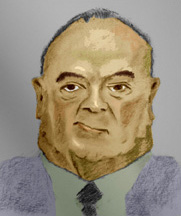
J. Edgar Hoover
Not a Boy Scout.
This consensus continued to grow, an opinion bolstered in the mid-1970's when things turned out rather poorly for Alger's adversaries. For one thing it was revealed that J. Edgar Hoover had not run the FBI on the goody two-shoes Boy Scout footing as thought previously. Instead Edgar had committed massive civil right violations against a number of American citizens.
Then in what surely must have brought a smile to Alger's face, his old nemesis, Dick Nixon, resigned his long coveted presidency rather than face certain impeachment and removal from office. It seems that Dick had, among other things, ordered the CIA to tell the FBI to halt the investigation of an illegal break-in that had been committed by members of his own re-election committee.
Then to top it all off, in 1975 the Pumpkin Papers were finally released. They consisted of blank film, unclassified documents with trivial information, and some confidential (but not secret) memos which had been already disclosed. The material was so innocuous that within days Alger was re-instated as a member in good standing of the Massachusetts Bar, fully qualified to practice law. The (re)swearing-in ceremony was carried on national television.
Then in 1991 the Soviet Union came a-tumblin' down. The files from Soviet spy agencies were now available. Among those who asked the Russians to check whether there was anything in the files about Alger Hiss was none other than Alger himself.
To his satisfaction, Alger was told there was nothing in the files. He died five years later, aged 92, and no doubt feeling he had been vindicated.
The times, though, had a-changed. Socialists, not to mention the Commies, had become personae non gratae in the United States (and just about everywhere else). Even being labeled a (ptui) liberal was the kiss of death for a political career. In this new era the more skeptical of historians suggested that perhaps, just perhaps, the search of the KGB archives that - quote - "exonerated" - unquote - Alger might have been superficial or at least incomplete.
And lo! With much fanfare, it was announced that the documents in the files of Soviet intelligence - by now called the KGB - showed that, by golly, Alger was indeed a spy working for the Soviets.
The key to the crux was that following the war, American intelligence had been intercepting and decoding messages from the Soviet Union. Some of the documents mentioned an American who was working as a spy. He was identified as a honcho in the US State Department and - get this - the spy had attended the Yalta Conference in 1945, and afterwards he had traveled with the American entourage to Moscow.
This description fit Alger perfectly. And more to the point, although the spy's name was never mentioned, his code name was ALES.
Ha? (To quote Shakespeare.)
Did you say ALES?
Yes, we said ALES.
ALES!!??!!
Yes, ALES.
Why, that could only mean:
ALgEr HisS.
So as the tumultuous 20th century waned and the 21st waxed, another truism took root. Alger Hiss had indeed been a Soviet spy and only the most naïve dunderheaded leftist would dare hold that Alger was innocent.
Case closed.
Correct?
Weheeeeeeeeeeeellllllll, not so fast.
We see that there is really no documentation that directly tells us what happened. Instead, conclusions about the guilt or innocence of Alger arise from the "Let's Put Together the Puzzle and Figure Out What Happened" school of history. That means you have to sift through mounds of documents, interviews, and records. Then by selecting the most creditable data you "reconstruct" THE TRUTH.
There is - as you may guess - just a wee-bit of a problem with this approach.
When reviewing historical evidence, there will always be found inconsistencies and contradictions. That leaves the historians to - quote - "interpret the data" - unquote. In other words, they toss out some evidence and keep the rest. Of course, what they keep or toss is affected not just by the data and its origins, but by their own peculiar* world view.
Footnote
peculiar : Belonging distinctively or primarily to one person, group, or kind; special or unique
And sure enough, just when you think everything was solved and we have finally decided that Alger was a spy - you guessed it - some wiseacres come along and say that the identification of ALES as Alger is dead wrong.
It seems that the Yalta group didn't just go to Russia. They also went to Mexico. We know ALES was with them because the Russian records state that ALES did indeed fly to Mexico and returned to Washington with the others in March.
But here's the catch. Alger did not return to Washington with the others.
Instead Alger came down with the flu and went home early. United States records clearly put him in Washington in February, not March.
Well, if the Russian records show ALES was in Mexico in March and Alger had returned to Washington in February, then - and pardon us if we shout:
ALES COULD NOT HAVE BEEN ALGER HISS!!!!!!
Therefore all this talk of how the wanderings of ALES prove Alger was spying for Russia is a red herring. If not completely vindicating Alger, it certainly sends us back to square one.
Weeeeellllll, hold on there - again.
Now we do admit that if this were a court case, finding a document saying ALES was in Mexico in March and Alger flew home in February might be a sufficiently strong alibi to at least instill reasonable doubt in a jury. So legally Alger might have gotten off.
But as far as historians judging the case, they would realize it is common - in fact the rule - that primary source material contains errors. After all, the writers of documents are human. They may get dates wrong, mistake one person for another, and may not be actual eyewitnesses for all the events they relate. So errors creep in.
The statement that ALES remained with the bunch in Mexico may indeed be one such error. That is, the actual writer of the memo may not have even been in Mexico and was unaware that Alger fell ill. So naturally he believed that Alger stayed in Mexico and returned with the rest in March.
So what, as Flakey Foont asked Mr. Natural, does it all mean?
Before arriving at THE TRUTH, perhaps the best thing to do is to compress and summarize everything into a nice neat - ah - compressed summary. We list items both pro and con for Alger as might appear in a gentlemanly debate between honorable opponents. For completeness, we will also include some points not expressly touched on above.
| Alger Hiss Point and Counter Point | |
| Point | Counter Point |
| Soviet intelligence officers have said that Alger was a Russian spy. | Soviet intelligence officers have said that Alger was not a Russian spy. |
| Alger was convicted for his crimes as a spy. | Alger was convicted of lying under oath before a grand jury. |
| Alger clearly lied under oath that he had not known Whit. | Whit had used an alias. Alger was not deliberately lying and hence not guilty of perjury. |
| Nothing Whit has ever said has been proven to be wrong. | Whit contradicted himself many times, such as when he said Alger was a spy only after repeatedly saying Alger was not a spy. |
| The Pumpkin Papers were copies of government documents and were typed on Alger's typewriter. | The Nixon tapes recorded Dick saying they "got the typewriter" to build the Hiss case, which some interpret that Dick obtained a new typewriter so they could forge evidence. |
| The so-called proof that leads some people to think Dick forged the Pumpkin Papers is based on a malapropism. Dick never said he "got the typewriter", but that he "got the piper". From the next sentence, it is clear that Dick meant to say "we got the papers", that is, the Pumpkin Papers. He was also probably thinking about the "Piper" law firm of which Alger's attorney was a partner. | The tape is garbled and some listeners claim Dick said "typewriter". |
| ALES, a Soviet spy mentioned in intercepted Russian communications, was clearly ALgEr HiSs. | No competent spy agency would make a code name so similar to the principal's actual name. For instance, ZVUK was the code name for a man named Jacob Golos. |
| The Soviets could be incredibly uncreative in crafting code names. SERGEY was the code for Vladimir Sergeevich Pravdin - far closer to his real name than ALES is to Alger Hiss. | Vladimir Sergeevich Pravdin was a Russian officer, and it was not as important to keep his identity secret as it would be for an American working as a spy. |
| The National Security Agency concluded ALES was Alger Hiss. | The National Security Agency concluded ALES was PROBABLY Alger Hiss. |
| ALES was at Yalta in 1945 and then went to Moscow, a schedule that fit perfectly with Alger's travels at the time | This itinerary fit many of the State Department's entourage. |
| ALES was independently identified as Alger Hiss by the KGB Colonel Oleg Gordievsky in 1988. This was well before the ALES documents were declassified in 1995. | Oleg's "knowledge" that ALES was Alger came from a news article that was written by an American journalist who had prior information of the classified documents. |
| ALES' time working as a Soviet spy was in the 1930's and 40's, which fit with Alger's time in the government. | The activities of ALES include passing on military information which Alger did not have access to. |
| The Pumpkin Papers did indeed contain military information. | The - quote - "military information" - unquote - in the Pumpkin Papers was not classified and like almost everything in the Papers was trivial. |
| After the Yalta Conference and the trip to Russia, the US delegation went to Mexico and returned to Washington in March. Alger was in the group and the Russian documents mention ALES was present. | Alger left Mexico early, returning to Washington in February. If ALES was in Mexico in March, he cannot have been Alger. |
| Alger's leaving Mexico early was not part of the original itinerary as he came down with the flu. The author of the Soviet memo most likely was simply unaware that Alger left early. | You can prove anything if you're allowed to make up the evidence. |
| Take a hike! | Ya fadder's mustache! |
All of this brouhaha not withstanding, it must be stated that the current scholarly opinion continues to be that Alger was guilty as charged and that he had been a spy. Short of finding a letter from Josef Stalin to Lavrenti Beria that says something like "Lavrenti, isn't it strange that Alger Hiss, the top level diplomat in the United States Department of State, has been accused of being a spy when we know he has always been the most loyal of Americans?", this consensus will probably remain for now.
As for what it all does mean, by now you may think Mr. Natural was right. But there is an absolute and indisputable TRUTH gleaned from the Case of Alger Hiss.
And what is this TRUTH?
The truth is that if you want to believe that Alger Hiss was a spy for the Soviet Union, you will be able to find all the evidence you need to prove your case. On the other hand, if you want to believe Alger was an innocent man who was framed by a group of vindictive politicians for their own political aggrandizement, you can find all the evidence to prove that as well.
And that's pretty much that.
References
Alger Hiss and the Battle for History, Susan Jacoby, Yale University Press, 2009.
Perjury: The Hiss-Chambers Case, Allen Weinstein, Knopf, 1978.
Witness, Whittaker Chambers, Random House, 1952.
"Unregretfully, Alger Hiss", Geoffrey C. Ward, American Heritage, Volume 39, Issue 7, 1988.
Alger Hiss: Why He Chose Treason, Christina Shelton, Simon and Schuster, 2012.
Venona: Decoding Soviet Espionage in America, John Earl Haynes, Yale University Press, 1999.
"Alger Hiss", Dietmar Starke, Encyclopedia Britannica.
"Alger Hiss", Spartacus Educational.
"Whittaker Chambers", Spartacus Educational.
"Priscilla Hiss", Spartacus Educational.
"Alger Hiss Trials (1949-50)", Douglas Linder, Famous Trials, University of Missouri-Kansas City.
"Lessons of the Alger Hiss Case", Richard Nixon, The New York Times, January 8, 1986.
The Alger Hiss Story: A Search for Truth, algerhiss.com.
"Framing a Guilty Man?", Jeff Kisseloff, Interview with Stephen Salant, The Alger Hiss Story: A Search for Truth.
Special Issue: USSR, Life Magazine, March 29, 1943.
Wikipedia. Although the accepted wisdom is never to use Wikipedia as a source, in this on-line encyclopedia there is much information which pertains to the debate regarding Alger's guilt or innocence. As far using Wikipedia as a source, physicians have been known to use it as a quick reference when they are initially stumped by some perplexing symptoms.